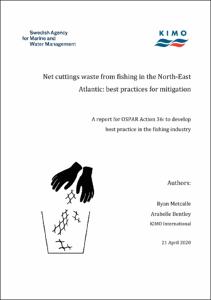| dc.contributor.author | Metcalfe, Ryan | |
| dc.contributor.author | Bentley, Arabelle | |
| dc.coverage.spatial | North Sea Region | en_US |
| dc.date.accessioned | 2021-10-15T21:17:09Z | |
| dc.date.available | 2021-10-15T21:17:09Z | |
| dc.date.issued | 2020 | |
| dc.identifier.citation | Metcalfe, R. and Bentley, A. (2020) Net cuttings waste from fishing in the North-East Atlantic: best practices for mitigation.
A report for OSPAR Action 36: to develop best practice in the fishing industry . Shetland, UK, KIMO International for Swedish Agency for Marine and Water Management, 61pp. DOI: http://dx.doi.org/10.25607/OBP-1656 | en_US |
| dc.identifier.uri | https://repository.oceanbestpractices.org/handle/11329/1745 | |
| dc.identifier.uri | http://dx.doi.org/10.25607/OBP-1656 | |
| dc.description.abstract | The issue of pollution from waste net cuttings needs to be addressed. These small items, found
in abundance on shores and in the marine environment, cause harm to marine wildlife through
ingestion and entanglement and to our fishing industry through damage to fishing gear. Simple,
effective solutions can be implemented by fishers and port authorities to collect and contain
pieces of net, rope and cord before they are washed to sea. Mitigation requires awareness
raising within the industry and engagement by fishers and harbour authorities to modify
existing work practices and use methods and tools to better manage cuttings waste.
On behalf of the Swedish Agency for Marine and Water Management, KIMO International
conducted a survey of harbour authorities and fishers from four countries in the North Sea
region in order to explore challenges and solutions to reducing the volume of waste net cuttings
from the fishing industry that end up in the sea.
This report presents an analysis of background research and of the results from the survey,
including feedback gained through face to face interviews. Information was gathered about the
sources of net cuttings and practices that mitigate inputs to the marine environment. Fishers
and harbour authorities contributed valuable information about current work practices,
attitudes towards disposal of cuttings, and evaluation of remedial measures. Recommendations
for next steps for national governments, ports and fishers are also provided in the report.
The surveys, a best practices guide and a set of awareness-raising materials have been
developed to accompany this report. It is our hope that these will be widely circulated and used
to raise awareness in the OSPAR maritime area, and in any area where commercial fishing
activities take place, thus preventing further inputs of waste net cuttings into our marine
environment. | en_US |
| dc.description.sponsorship | Swedish Agency for Marine and Water Management | en_US |
| dc.language.iso | en | en_US |
| dc.publisher | KIMO International for Swedish Agency for Marine and Water Management | en_US |
| dc.subject.other | Plastic pollution | en_US |
| dc.subject.other | Fishing gear | en_US |
| dc.subject.other | Net cuttings | en_US |
| dc.subject.other | Fishing nets | en_US |
| dc.title | Net cuttings waste from fishing in the North-East Atlantic: best practices for mitigation. A report for OSPAR Action 36: to develop best practice in the fishing industry. | en_US |
| dc.type | Report | en_US |
| dc.description.status | Published | en_US |
| dc.format.pages | 61pp. | en_US |
| dc.description.refereed | Non Refereed | en_US |
| dc.publisher.place | Shetland, UK | en_US |
| dc.subject.parameterDiscipline | Anthropogenic contamination | en_US |
| dc.subject.parameterDiscipline | Human activity | en_US |
| dc.description.currentstatus | Current | en_US |
| dc.description.sdg | 14.1 | en_US |
| dc.description.eov | Marine debris | en_US |
| dc.description.adoption | International | en_US |
| dc.description.methodologyType | Method | en_US |
| dc.description.methodologyType | Specification of criteria | en_US |
| obps.contact.contactname | KIMO International | |
| obps.contact.contactemail | info@kimointernational.org | |
| obps.resourceurl.publisher | https://www.kimointernational.org/ | |
 Repository of community practices in Ocean Research, Applications and Data/Information Management
Repository of community practices in Ocean Research, Applications and Data/Information Management
